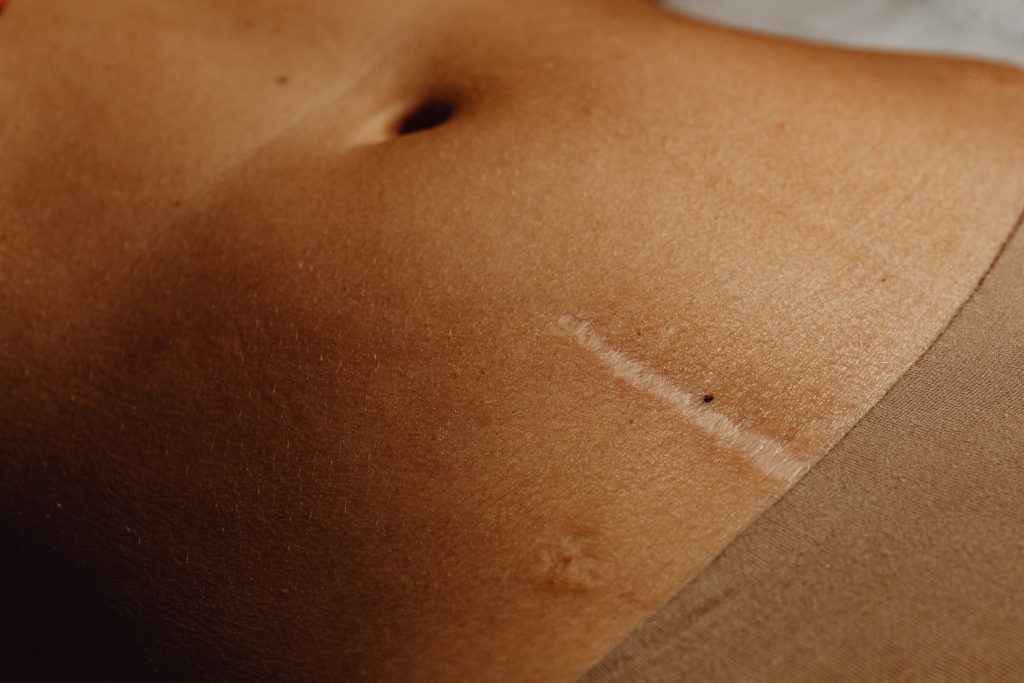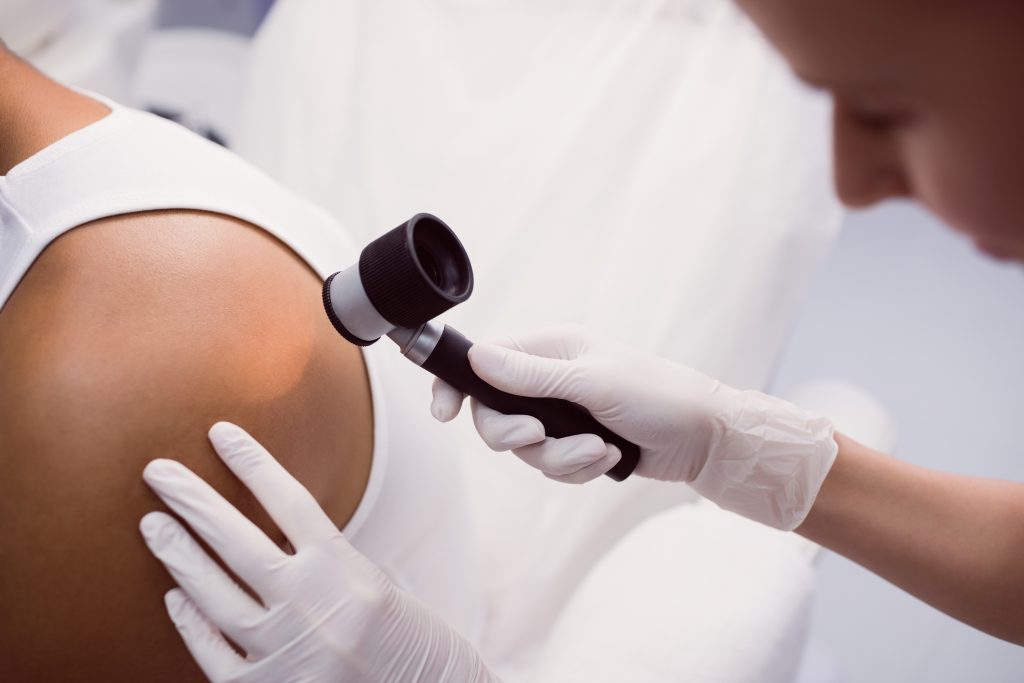Discover effective in-office treatments that can help reduce the appearance of scars.
In-Office Treatments to Reduce the Appearance of Scars
Scars can be a real confidence crusher. Whether they’re the result of an accident, surgery, or even acne, those pesky reminders of the past can really take a toll on our self-esteem. But fear not! There are plenty of in-office treatments available that can help reduce the appearance of scars and give you back your confidence.
Understanding Scars and Their Impact on Confidence

Before we dive into the world of scar reduction treatments, let’s take a moment to understand what scars are and how they affect our self-esteem.
Scars are not just physical marks on our skin; they can carry emotional weight as well. They are the body’s natural way of healing after an injury, surgery, or even a pimple. When the dermis, or the deep layer of the skin, is damaged, the body goes into repair mode. It produces collagen fibers to mend the wound, creating a scar in the process. These collagen fibers can sometimes create a different texture or color on the skin, resulting in a scar that stands out.
Scars can vary in size, shape, and appearance. Some scars are small and barely noticeable, while others may be larger and more prominent. Regardless of their size, scars can have a significant impact on our self-esteem. They can serve as constant reminders of past traumas or insecurities, making us feel self-conscious and less confident in our appearance.
Imagine a person who has a scar on their face from a childhood accident. Every time they look in the mirror, they are reminded of that moment and the pain associated with it. This constant reminder can take a toll on their self-image and confidence. They may feel like their scar defines them, overshadowing their other features and qualities.
It’s not just the physical appearance of scars that affects our self-esteem. The emotional weight attached to scars can be equally impactful. Scars can carry memories of difficult times, reminding us of moments we’d rather forget. They can become a source of anxiety, as we worry about how others perceive us and whether they judge us based on our scars.
The good news is that there are treatments available to minimize the appearance of scars and help us feel more comfortable in our own skin. Scar reduction treatments can range from topical creams and ointments to more advanced procedures such as laser therapy and microdermabrasion. These treatments work by stimulating collagen production, reducing inflammation, and improving the overall texture and appearance of scars.
However, it’s important to remember that scars are a natural part of our body’s healing process. While treatments can help minimize their appearance, it’s also essential to embrace our scars as a part of our journey. Each scar tells a story of resilience and strength, reminding us of the challenges we have overcome.
So, the next time you come across a scar, whether it’s on yourself or someone else, remember that it’s more than just a physical mark. It’s a reminder of the human capacity for healing and growth. And while treatments can help improve the appearance of scars, true confidence comes from accepting and embracing our scars, knowing that they are a testament to our strength and resilience.
Types of Scars and Their Treatments
Not all scars are created equal. There are different types of scars, each requiring a specific treatment approach. Let’s take a look at some common types of scars and how they can be treated.
Scars can be a lasting reminder of past injuries or skin conditions. They can affect our self-esteem and confidence, making us feel self-conscious about our appearance. Fortunately, there are various treatment options available to help minimize the appearance of scars and improve their overall texture.
Keloid Scars
Keloid scars are characterized by their raised, thick appearance. They can be itchy and may continue to grow over time. These scars occur when the body produces too much collagen during the healing process, resulting in an overgrowth of scar tissue. Keloid scars can be challenging to treat, but there are options available.
In-office treatments for keloid scars often involve corticosteroid injections to reduce inflammation and flatten the scar. These injections help break down the excess collagen and promote a more even skin texture. Additionally, cryotherapy, which involves freezing the scar tissue, can be used to reduce the size and thickness of keloid scars.
Hypertrophic Scars
Hypertrophic scars are similar to keloid scars, but they usually do not extend beyond the boundaries of the original wound. These scars are caused by an overproduction of collagen, similar to keloids, but they tend to be more responsive to treatment.
When it comes to treating hypertrophic scars, silicone sheets or gels are often recommended. These products create a protective barrier over the scar, helping to flatten and soften its appearance. The silicone sheets can be worn for several hours each day, gradually improving the scar’s texture over time. Other treatments, such as laser therapy or corticosteroid injections, may also be used to further reduce the size and redness of hypertrophic scars.
Atrophic Scars
Atrophic scars are sunken or depressed scars that often result from acne or chickenpox. These scars occur when there is a loss of underlying tissue, leaving a visible indentation on the skin’s surface. Atrophic scars can be emotionally distressing for individuals, but treatment options are available to help improve their appearance.
In-office treatments for atrophic scars may include dermal fillers, which can help plump up the skin and reduce the appearance of the scar. These fillers are injected directly into the depressed area, raising it to the level of the surrounding skin. The results are temporary but can last several months. Other treatments, such as microdermabrasion or chemical peels, may also be used to improve the overall texture and tone of the skin, reducing the visibility of atrophic scars.
It’s important to remember that the effectiveness of scar treatments can vary depending on the individual and the severity of the scar. Consulting with a dermatologist or a plastic surgeon is recommended to determine the most suitable treatment approach for your specific scar type.
Popular In-Office Scar Reduction Treatments
Now that we’ve covered the different types of scars, let’s explore some of the popular in-office treatments that can help reduce their appearance.
Scars can be a constant reminder of past injuries or surgeries, affecting both our physical appearance and self-confidence. Fortunately, there are various in-office scar reduction treatments available that can help diminish the appearance of scars and improve the overall texture and tone of the skin.
Laser Therapy for Scar Reduction
Laser therapy is a popular scar reduction treatment that uses focused light to target the scar tissue. This innovative technology can penetrate deep into the skin, stimulating collagen production and promoting the growth of new, healthy skin cells.
During a laser therapy session, the dermatologist or aesthetician will carefully maneuver the laser device over the scarred area. The laser energy is absorbed by the scar tissue, causing it to break down and gradually fade away. Multiple sessions may be required for optimal results, but the benefits can be well worth it.
Aside from reducing the appearance of scars, laser therapy can also improve skin texture, minimize wrinkles, and even out skin tone. It’s a versatile treatment that can address multiple skin concerns simultaneously.
Chemical Peels for Scar Treatment
Chemical peels are another effective in-office treatment for scar reduction. This procedure involves applying a chemical solution to the skin, which causes it to exfoliate and eventually peel off. By removing the damaged outer layers, chemical peels can significantly improve the texture and tone of the skin, reducing the appearance of scars.
There are different types of chemical peels available, ranging from superficial to deep peels, depending on the severity of the scars and the desired results. Superficial peels are milder and require little to no downtime, while deep peels may involve more significant peeling and a longer recovery period.
Chemical peels can be customized to target specific types of scars, such as acne scars or surgical scars. The dermatologist will assess your skin condition and recommend the most suitable type of peel for your needs.
Microdermabrasion for Scar Smoothing
If you’re looking for a non-invasive treatment to improve the appearance of scars, microdermabrasion might be the answer. This procedure uses a handheld device that emits tiny crystals to gently exfoliate the outer layer of the skin.
During a microdermabrasion session, the crystals are sprayed onto the skin and then vacuumed away along with the dead skin cells, revealing a smoother and more rejuvenated complexion. By removing the damaged skin cells, microdermabrasion can help smoothen the appearance of scars and improve overall skin texture.
Microdermabrasion is a quick and painless procedure that requires no downtime. It’s often described as a “lunchtime” treatment because you can easily fit it into your busy schedule without any disruption.
It’s important to note that while these in-office scar reduction treatments can significantly improve the appearance of scars, they may not completely eliminate them. The results can vary depending on the individual’s skin type, the severity of the scars, and other factors. It’s always best to consult with a qualified dermatologist or aesthetician to determine the most suitable treatment plan for your specific needs.
What to Expect During a Scar Treatment Session
Now that you’re excited about the possibilities of scar reduction treatments, let’s talk about what you can expect during a typical in-office session.

Preparing for Your Appointment
Before your scar treatment session, it’s important to follow any pre-treatment instructions given by your healthcare provider. This may include avoiding certain medications, applying numbing cream, or cleansing the area to be treated. Be sure to ask any questions you have beforehand to ensure you’re fully prepared.
During the Treatment
During the actual scar treatment session, your healthcare provider will perform the chosen procedure, whether it’s laser therapy, a chemical peel, or microdermabrasion. The length of the session will vary depending on the treatment and the area being treated. Some treatments may cause minor discomfort, but your provider will do their best to keep you comfortable throughout the process.
Post-Treatment Care and Recovery
After your scar treatment session, it’s essential to follow your healthcare provider’s post-treatment care instructions. This may include avoiding excessive sun exposure, applying healing ointments or creams, or avoiding certain activities that could irritate the treated area. Remember, proper care and patience are key to seeing the best results from your scar reduction treatment.
So, whether you’re struggling with keloid scars, hypertrophic scars, or atrophic scars, there is hope. In-office treatments can work wonders in reducing the appearance of scars and boosting your confidence. Don’t let scars hold you back from feeling fabulous in your own skin – explore the world of scar reduction treatments and embrace your beautiful self!





